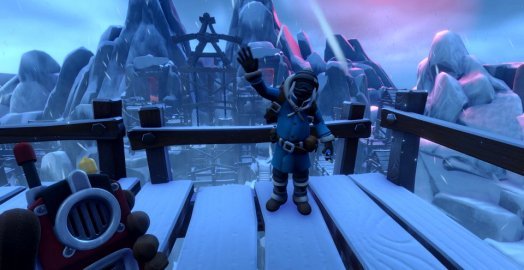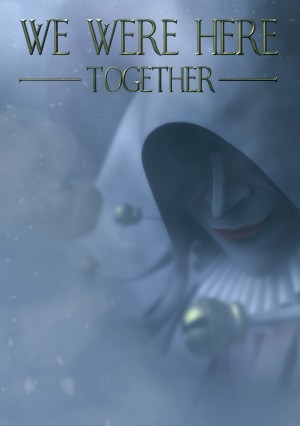Review for We Were Here Together

We Were Here Together is the third installment in Total Mayhem’s two-player co-op adventure series. I was under the impression that familiarity with the prior games – the free We Were Here and its first commercial sequel We Were Here Too – was unnecessary. Having not played the first two games, in tackling this latest entry I would agree with that assessment as it pertains to the strongest aspect of the game, that being the joint solving of its many escape rooms. However, narratively my friend and I felt that we were missing something, possibly from the previous games. Even so, we had a lot of fun with this shared adventure and are now planning on going back and giving the earlier games a go at some point as well.
As with its predecessors, the core focus of We Were Here Together is collectively working through puzzle challenges with a partner online. Each player takes control of a nameless character swathed in either blue or orange cold-weather gear appropriate for the small arctic research facility in which the game opens. Wandering through a couple of rooms at the little base quickly reveals a fragmented distress call from another member of the research team. Working together, one player needs to go outside and adjust the controls for a radio antenna while the other remains indoors to relay the effects of the changes.
To facilitate communication between the two players, each one has a walkie-talkie with a “push to talk” button, allowing one person at a time to speak right within the context of the game. Unfortunately, for me and my friend we found that even with the chat volume maxed out it was only coming through slightly higher than the level of a whisper, so we quickly abandoned the built-in voice feature for a separate chat application outside of the game.
Our first technical hurdle surmounted, we both quickly became immersed in the challenges being offered. For the most part, the game does an excellent job of ramping up the difficulty as it goes along. Early on the tasks are easier because both players are in the same area and so can see and interact with the same things. Most of the puzzles at this stage involve finding information in one part of the environment and using it to operate machinery, create potions from recipes, or to arrange objects in certain configurations in order to overcome obstacles somewhere else. For example, a series of paired elevators with different symbols on them are encountered early on. When one person gets in an elevator and moves it one way, the corresponding elevator moves the other way. Players have to coordinate which elevators they’re standing in based on the glyphs the elevators display in order to ascend upwards through the whole system, which requires frequent changes of the lifts being used.
Before long the two protagonists leave their home base and enter an impressive medieval-looking structure that is a cross between a cathedral and a fortress set into the side of a mountain. Here you’ll become separated, each player having their own set of rooms to explore. The set each player gets is dependent on which of the two paths you choose to take through a specific challenge area about a third of the way in. Once separated, both partners are completely reliant on the other’s ability to communicate and describe their own circumstances. This communication is key to success and I was glad to have a friend along who knows how I think and vice versa, as that made describing things simpler and consequently solving the puzzles easier (not to say they were ever easy).
In the event that you don’t have a friend available to play with, We Were Here Together does offer a matchmaking service. Games can be set up as either public or private. Private games require an invite to be sent from the game to a recipient on your Steam friends list to allow them to join in. I didn’t try connecting with anyone through this service, but there were usually two or three publicly open games running whenever my friend and I went online together.
The game environment is broken into distinct sections or rooms. Regardless of whether the two characters are together or apart, you are confined to the current area until its overall puzzle or puzzles are solved, which typically results in a door or other pathway opening to allow further progress. The general feel is that of working through a series of successive escape rooms. I was particularly taken with one involving a giant carnivorous plant (fortunately in my friend’s room), which not only required communicating details back and forth, it also included a small minecart for transporting needed inventory items between my room and his.
Each new scene has increasingly more complex information that needs to be shared with your partner. In the early stages it can be as simple as describing certain coloured liquids to combine, but later on it becomes much more complicated. In one puzzle requiring various ingredients to be mixed to create a mystical stone, I found myself confronted with a blackboard showing letter abbreviations for items to add together. My friend had to decipher the abbreviations to tell me the full names, which are intentionally very close together in spelling except for a few letters, so I could look them up in a series of pages available only to me with sketches of the needed items. As the sketches were quite detailed, but also very similar, it got a bit tricky getting the key information back across. Here we were exchanging such illuminating descriptions as “a melting ice cream mushroom” or “the double-headed daisies.” It proved to be surprisingly challenging to distinguish a “grumpy carrot” from an “angry turnip” (but in a good way!).
Both my friend and I agreed that the path I was on leaned a little bit more to an adviser’s role and the path he was on to the doer’s. To be sure, I had a good dose of machines to manipulate, ingredients to combine, and objects to rearrange, but he seemed to be doing more of the mechanics of solving things with me providing more support. Although the game generally ramps up in difficulty due to ever-increasing complexity throughout, the final challenge we faced stepped back from this trend with a different approach. Instead of presenting an even more layered and complex puzzle, it went for fewer pieces but with a timed element. Failing to solve the problem in the period allotted resulted in the death of my friend’s character several times.
The last task isn’t the only timed segment, mind you, only the most elaborate. In a couple of other instances my friend found himself in rooms that became traps as we neared the end of completing them, such as when he entered a chamber with water rising to drown him as the final part of a larger puzzle chain. Here he was dependent on me manipulating a series of gears in my room to help get him out of his predicament. I hadn’t quite realized the seriousness of his situation at first, but I was able to solve the puzzle on my side to get him out in time. In other situations I maaay not have been quite fast enough to save him, which resulted in both his character dying and a lot of laughter between the two of us. In those instances, after he died we were able to restart the challenge from the beginning again so never really lost any significant progress (which is good as the game offers no free save ability). Although timed, we never found scenarios such as these to be punishing or feel unfair.
We did encounter one buggy area in We Were Here Together, and judging by the Steam forums we weren’t the only ones, though the issue doesn’t appear to be widespread. At one point players must rotate paintings in similar libraries in order to acquire an item, but the rotation mechanics didn’t work properly for my friend. Fortunately a separate glitch allowed a workaround to attain the object anyway so we could proceed. A recent update, however, has corrected the workaround but not the original problem, meaning that some unlucky players might find themselves permanently stuck in that area. The developers are aware of the issue and plan to correct it in their next patch, but be aware that it might be an issue until then.
Visually the game employs a semi-realistic look. There’s a fair degree of detail in the textures while the geometry itself is rounded or askew, giving it a slightly cartoon feel. It’s a pleasant esthetic applied across the different locations ranging from the cozy research station, to the surrounding polar tundra with snow drifting down from overhead, to the various stone and wood-lined rooms of the fortress. A lot of mechanical equipment can be found throughout whose wood and metal construction and plethora of gears and pipes elicit something of a steampunk vibe. Some areas are dark, but never to the point where details cannot be made out, except in a particular puzzle where it is necessary for one player to light up parts of the room the other player is in.
As so much of our attention was given over to the puzzles and communicating information back and forth, the other elements of the game tended to fade into the background. Instrumental music, for instance, serves as accompaniment along the way but the only memorable tune for me was the short piano trill that would play upon completion of the main challenges. Sound effects fit the environments, whether it’s the blowing of steam through pipes or the rumble of elevators in motion. The voice work too is competently done.
Wait. Voice work besides your own? Yes, We Were Here Together does indeed have a few non-player characters in it that contribute to each partner’s respective storyline. The interwoven narrative progresses through cinematics that separate most of the major puzzles. My friend encountered another member of the research team who helped guide him forward. I never saw anybody until late in the game, instead only hearing echoes of the past as a man and woman discussed an enchanted dagger that could free a soul from a body.
The story suffered from the two-player format for me and my friend, though more from us being so focused on the puzzle solving than any great writing deficiency. In essence, for us it felt more like background noise than something we were actively interested in and we could have done just as well without it. The final wrap-up, which we reached after nearly eight hours of play, is odd and neither of us really knew what to make of it, leaving us both wondering if certain elements would have made more sense if we had played the previous installments in the series.
While a functional microphone is a must for each player, control is handled through mouse/keyboard or game controller. I tried the former and my friend the latter and we didn’t encounter any issues to speak of, save for the gamepad posing a bit of difficulty navigating the game’s menu. We did have a little trouble accessing our inventories early on – there are a handful of objects that can be picked up along the way – but that was because we didn’t realize at first that the inventory only appears at the bottom of the screen when you’re looking at an interactive area where an item can actually be used.
On a quality of life note, it’s possible to run to cover some of the larger distances and the options allow for either holding the button manually or toggling the feature on and off (thank you, developers!). There are also controls to make your otherwise unseen in-game avatar point or wave, causing their hands to appear on-screen to perform the gesture. There’s something ridiculously fun about climbing to some height or crossing a chasm and then turning around and waving to your partner on the other side. It’s a bit of a shame, really, that most of the game is spent separated so that these actions can’t be utilized more.
We Were Here Together is a fun and engaging challenge for two players, offering as much a test of each partner’s ability to communicate as cracking the conundrums. While a few bugs have crept into the experience and the story isn’t exactly prominent or clearly explained (at least to series newcomers), the process of solving puzzles cooperatively is at the core here, and in that the game succeeds extremely well, with no repeated puzzles or duds in the bunch. There are some games you play that, when finished, you wish they would keep going for just a little longer. So it is with this one for me and my friend. It’s a shame that there isn’t more randomization to make a replay in the opposite role more appealing, but fortunately we have the two earlier titles to go back and delve into, plus more sequels on the horizon to look forward to. Both partners will need to own their own copies of the game, but if you’re looking for some complex brainteasers to share with a friend to capture a bit of that escape room vibe, this is certainly the right place to look.
WHERE CAN I DOWNLOAD We Were Here Together
We Were Here Together is available at:
We get a small commission from any game you buy through these links (except Steam).Our Verdict:
We Were Here Together provides a great assortment of co-op challenges that will test your ability to communicate vocally as well as to solve them together.
You don't want to miss these articles
Adventure Gamers Community
Community reviews for more Adventure Games (randomly selected)
Review of Ben Jordan: Paranormal Investigator - Case 8: Relics of the Past
Rating by Niclas (Nov 8, 2012)
Review of Ben Jordan: Paranormal Investigator - Case 8: Relics of the Past
Rating by Niclas (Nov 8, 2012)






























